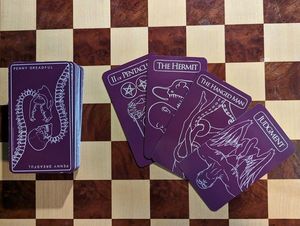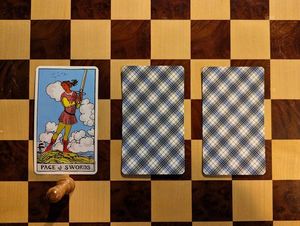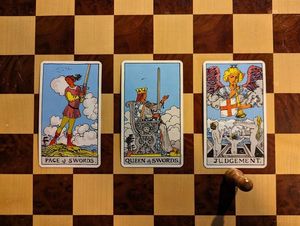Reading the Veil
By Peter Counter
When it’s going well, writing feels like magic. You sit in front of a blank page, and against all expectation, open a portal to new people, scenarios, settings, and ideas. Through some synthesis of presence, self-reflection, and typing, a writer discovers thoughts they didn’t know they had. I expect this is why so many of us are drawn to the tarot. The famous divinatory cards are an interface between humans and the hidden worlds surrounding us in daily life, offering novelty, self-reflection, and the promise of revelation. Draw a single card and uncover a story prompt or inspiration for a character. Flip three onto a table and see a narrative unfold act by act. The dense symbolism of the tarot takes advantage of a writer’s natural storytelling drive, reframing and transforming our assumptions into something fresh and unexpected.
I received my first tarot deck at work. I’d been assigned to write about the second season launch of Showtime’s Penny Dreadful—a monster mashup serial starring Eva Green as she navigated a fantasy version of Victorian London populated by Victor Frankenstein, the weird sisters from Macbeth, Dracula, Dorian Gray, and an American werewolf. Snaking into the theatre with other critics and media professionals, a woman at the door handed me a soft red bag, tied shut with its own drawstrings. I opened it on the way to my seat and found a replica set of the tarot cards Green’s character used in the show. The only difference being that hers were well worn cardstock and mine were freshly plasticized and stamped with the name of the show they represented.
At the time, I was a nihilist-leaning atheist, skeptical on my most generous days. Not exactly mystic material. But those promotional cards wormed their invisible tendrils into my enthusiasm for kitschy marketing tie-in objects and the dormant spirituality of my Catholic school upbringing. I tried them out at home, using internet guides to help me read their meanings, and it wasn’t long until I sought more serious decks, eventually landing where all the tarot curious do: the famous Rider-Waite set, illustrated by occultist Pamela Colman-Smith. The whole time, I was amazed at my shifting perspective. I’d avoided tarot because I found little value in serious fortune telling but when it took the form of a TV-show tie-in toy, I saw divination in a new light and discovered a fun way to self reflect.
Alongside the actual tarot cards in that Penny Dreadful collection, there were a few white, Showtime-branded inserts with basic instructions on how to use the deck. The directions showed a diagram of a three-card spread called “The Veil.” It’s easy to set up, easy to read, and focused on the present, making it perfect if, like me, you find future-sight unappetizing.
The Veil starts simply: the first card asks you behold it and see how it represents a part of your life. Because of the tarot’s heavy symbolism, and the richness of human experience, it’s never too difficult to make the match.
In this example, the Page of Swords asks you to see the energy and creativity bursting from your life. Once you find that dynamism and excitement, prepare to reframe it. There is more to this situation, but you cannot see it, obscured as it is by the second card, the titular shroud.
The second card in the spread represents an element in your current circumstances that is obscuring the true nature of what you see in the first card. In this example, the Queen of Swords indicates a mindset that is highly intelligent, clear, and rational. In this configuration the cards are asking you: is your logical approach to the energy and creativity represented by the Page of Swords preventing you from seeing something else important about your current reality?
In the Veil, the answer to that question is always yes, because interacting with the occult is to concede that you rarely see the full picture. And that brings us to the final card in the set. The third card on the table represents the full, true shape of reality. This is what the Queen of Swords is obscuring, and which your dialogue with the cards has allowed you to glimpse.
In this example, the reality of the situation is quite significant. Judgement, a card belonging to the major arcana, represents a fundamental change that will require both intellect and emotion. Perhaps the burst of creativity and energy represented by the Page of Swords is motivated by your changing circumstances, which you could not see for what it was behind the curtain of reason represented by the Queen of Swords. Judgement asks you to see where that change might be, and how it will require both rational mind and open heart to navigate.
Like all elements of the occult, this tarot configuration is best engaged with soft focus. Accept the cards as questions, and you will be able to find the parts of your experience they describe. That ephemeral nature is what makes this spread such a useful writing tool. By simply applying the questions normally meant for yourself to elements of your work-in-progress (a character, a setting, a narrative situation), or your practice (a memory you’re writing about, a familiar topic you need to see with fresh eyes), you can interrogate writing as you might reflect on your life. Read the Veil with an open mind and you might uncover meaning in places you’d never expect, like finding spiritual revival in a piece of mass-produced marketing gimmick for a show about wolfmen and vampires—a piece of wonder in a toy.
Your CanLit News
Subscribe to Open Book’s newsletter to get local book events, literary content, writing tips, and more in your inbox
The views expressed in the Writer-in-Residence blogs are those held by the authors and do not necessarily reflect the views of Open Book.
Peter Counter is a culture critic writing about television, video games, film, music, mental illness, horror, and technology. He is the author of Be Scared of Everything: Horror Essays and his non-fiction has appeared in the Walrus, All Lit Up, Motherboard, Art of the Title, Electric Literature, and the anthology Empty the Pews: Stories of Leaving the Church. He lives in Dartmouth, Nova Scotia. Find more of his writing at peterbcounter.com and everythingisscary.com.







